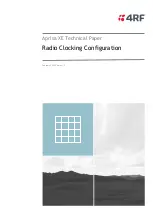
Radar/Chart Radar User Guide
Targets
65900010 10-3
Target Data received from TLB Sentence
If target data is being received from legacy radar equipment (for example, a
BridgeMaster E [BME] or other radar hardware) via a port on the PCIO
used for TLB communications, then target names may also be prefixed with
the contents of the TLB message's label field in parentheses, with a space
between this TLB name and the name assigned internally.
If this option has been configured (as described in section 8.9.1 `
Target
Rename Input
' in Chapter 1 `
Configuration'
of the VMFT Ships Manual
Volume 2) then the operator is still able to change the last part of the name
as long as the correlated target does not have an AIS target associated
with it.
Tracking Targets on a Multi-Node System
On a multi-node system one node is responsible for correlating targets at
any one time. The correlation information is distributed to ensure target
numbering across all nodes is identical. Also, a target name that has been
entered on a node is distributed to all other nodes on the system.
Only local tracked targets, acquired by the operator on a Radar or Chart
Radar node are displayed. These tracked targets will not appear on other
nodes unless the operator manually acquires the same target.
When a target, previously acquired on another node is selected to be
tracked the system may initially assign the latest target number to it,
depending on the proximity of the selection made to the targets actual
position (see Target Association values in Limits and Settings). This
number will change to the correlated number once the target is tracked,
(i.e. the number assigned to the target when it was first acquired.)
Where a target is correlated with a tracked target from an external input,
such as a BME, AIS and local tracked targets take priority over the external
input target, regardless of the display priority selected.
Tracking Targets on a Dual Radar System
On dual radar, targets are acquired as described for a single system,
providing the targets are within the tracking range (0.25NM to 40NM) for
both transceivers.
Video from both transceivers is used to track targets, with a single vector
displayed at the target position. The system displays the better of the target
information obtained, based on a combination of reported accuracy
information from the tracker, along with consideration of the number of
times video has been seen or not seen for the target.
Summary of Contents for VisionMaster FT
Page 1: ...Radar Chart Radar User Guide Northrop Grumman Sperry Marine B V Part Number 65900010 ...
Page 2: ......
Page 4: ...Radar Chart Radar User Guide 65900010 ii Intentionally Blank ...
Page 24: ...Overview Radar Chart Radar User Guide 1 2 65900010 Single System ...
Page 42: ......
Page 114: ......
Page 212: ......
Page 304: ......
Page 370: ......
Page 450: ......
Page 462: ......
Page 502: ......
Page 516: ......
Page 532: ......
Page 533: ......
















































